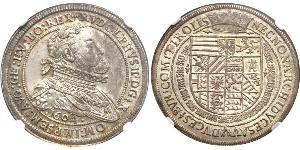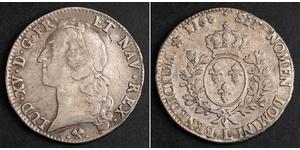3 Kreuzer (售价 $14.0)
1666, Emperor Leopold I "the Hogmouth". Scarce Silver 3 Kreuzer Coin. Breslau!
Mint Year: 1667 Reference: KM-1230. Ruler: Leopold I "the Hogmouth". Denomination: 3 Kreuzer (Groschen) Mint Place: Breslau (Wroclaw, Poland) Condition: Light creasing damage and minor corrosion pits, otherwise F-aVF! Assayer: Wardein Salomon Hammerschmidt (SHS) Diameter: 20mm Weight: 1.59gm Material: Silver
Obverse: Wreathed and armoured bust of Leopold right. Faced shoulder drapery. Legend: . LEOPOLD . D . G . R . I . S (3) . A . G . H . B . R . Translation: "Leopold, by the grace of God, Emperor of the Romans, Ever Augustus, King of Germany, Hungary, and Bohemia" Reverse: Double headed eagle of the Holy Roman Empire, crown above, shield at chest. Legend: ARCHID . AV . (SHS) D . BVR . ET . SIL . 16 - .66. Translation: "Archduke of Austria, Duke of Burgundy and Silesia"
Leopold I possessed a more extreme example of the Habsburg jaw which is evident from his portraits which depict it rather consistently. On his coins this feature is depicted less consistently ranging from a slight protrusion to the extremely pronounced distended jaw which led to the nickname: Leopold the Hogmouth.
Bid with confidence!
Leopold I, Holy Roman Emperor (name in full: Leopold Ignaz Joseph Balthasar Felician) Habsburg (June 9, 1640 - May 5, 1705), Holy Roman emperor, was the second son of the emperor Ferdinand III and his first wife Maria Anna of Spain. His maternal grandparents were Philip III of Spain and Margarita of Austria.
He was a younger brother of Ferdinand IV of Hungary and Mariana of Austria. Intended for the Church, he received a good education but his prospects were changed by the death of his elder brother Ferdinand IV, on July 9, 1654 of smallpox, when he became his father's heir.
Leopold was physically unprepossessing. Short and sickly, he had inherited the Habsburg lip to a degree unusual even in his inbred family. One contemporary said of him "His gait was stately, slow and deliberate; his air pensive, his address awkward, his manner uncouth, his disposition cold and phlegmatic".
In 1655 he was chosen king of Hungary and in 1656 king of Bohemia,1657 king of Croatia and in July 1658, more than a year after his father's death, he was elected emperor at Frankfurt in spite of the intrigues of Jules Cardinal Mazarin, who wished to place on the imperial throne Ferdinand Maria, Elector of Bavaria or some other prince whose elevation would break the Habsburg succession.
Mazarin, however, obtained a promise from the new emperor that he would not send assistance to Spain, then at war with France, and, by joining a confederation of German princes, called the league of the Rhine, France secured a certain influence in the internal affairs of Germany. Leopold's long reign covers one of the most important periods of European history; for nearly the whole of its forty-seven years he was pitted against Louis XIV of France, whose dominant personality completely overshadowed Leopold. The emperor was not himself a man of war, and never led his troops in person; yet the greater part of his public life was spent in arranging and directing wars. The first was with Sweden, whose king Charles X found a useful ally in the prince of Transylvania, György II Rákóczi, a rebellious vassal of the Hungarian crown.
This war, a legacy of the last reign, was waged by Leopold as the ally of Poland until peace was made at Oliva in 1660. A more dangerous foe next entered the lists. The Ottoman Empire interfered in the affairs of Transylvania, always an unruly district, and this interference brought on a war with the Holy Roman Empire, which after some desultory operations really began in 1663. By a personal appeal to the diet at Regensburg Leopold induced the princes to send assistance for the campaign; troops were also sent by France, and in August 1664 the great imperialist general, Raimondo Montecuccoli, gained a notable victory at Saint Gotthard. By the Peace of Vasvár the emperor made a twenty years' truce with the sultan, granting more generous terms than his recent victory seemed to render necessary.

|
发布人:
anonymous 2018-04-04 |
|
||
|
||
|
||
|
||
|
||
1 Ecu 中世纪的法国 銀 路易十五 (1710 - 1774)
本组有 14 钱币 / 13 售价
⇑
150 coins were grouped from 2025-04-30 to 2025-05-07
其中一个是:
1 Florin 大不列颠及爱尔兰联合王国 (1801 - 1922) 銀 维多 ...
本组有 50 钱币 / 44 售价
⇑

-600-300-_I0KqUpYtXAAAAFi3iSs748g.jpg)

-300-150-r8YKb0OMGe4AAAFEdUa7BEMl.jpg)
 Deutsch
Deutsch Русский
Русский Українська
Українська English
English Italiano
Italiano Français
Français Español
Español 汉语
汉语







-300-150-NFEKbzbi_VgAAAFLIcbk0KjK.jpg)
-300-150-UcUKX9IS93YAAAFbhmyt4uEz.jpg)





